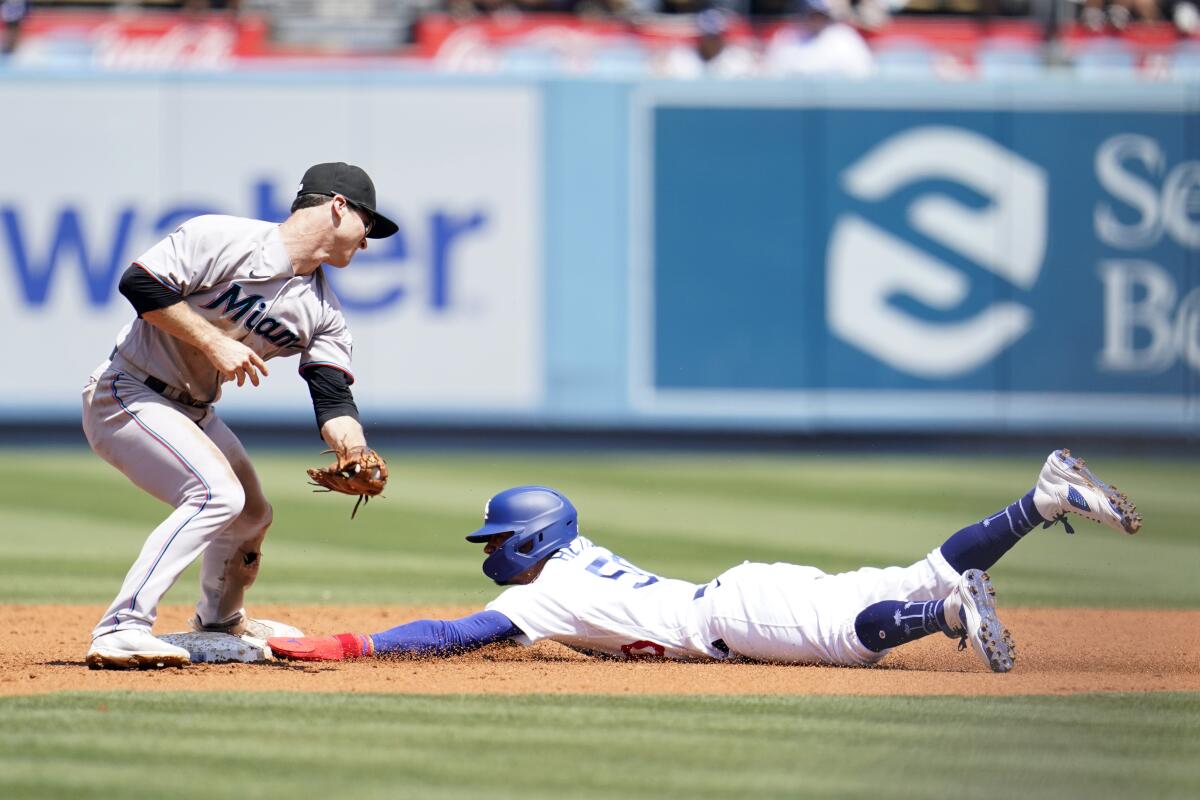Theft on the rise: How the Dodgers became baseball’s improbable men of steal

- Share via
The Dodgers’ preferred method of offense is to bludgeon opponents with a loaded lineup of power hitters proficient at working counts, hunting mistakes and giving themselves self-congratulatory taps on their helmets as they circle the bases.
Pointing out their proficiency at stealing bases is a bit like reaching under a stack of C-notes to rummage through the change drawer.
Stealing bases is so pre-analytics, so anti-Moneyball, so Maury Wills. Risking an out on the basepaths is nearly as passé as a sacrifice bunt. Stay put or be the target of a running joke.
Why then are the Dodgers exemplary men of steal?
Entering play Monday, the Dodgers had 78 stolen bases while being caught just 14 times. They are on pace to steal 105, easily their highest total since 2014 when Dee Strange-Gordon skewed the category by pilfering 64. Their success rate this season (84.8%) is exceeded only by the Chicago White Sox, who are 41 for 48 (85.4%).
Hernández: Dodgers’ destruction of Sandy Alcantara isn’t a fluke. This team can hit good pitching
The Dodgers’ performance against Marlins ace Sandy Alcantara proves they’re more than capable of racking up hits and runs against the best pitching.
The increased thefts also should keep the Dodgers sharp for the pressure-packed playoffs, when stealing bases becomes easier and more impactful. They were 16 for 16 in the 2021 playoffs and 31 for 32 the last three postseasons, an impeccable success rate of 97%.
Sabermetricians say the success rate at which an attempt to steal is helping a team is about 70%. The overall success rate this season in Major League Baseball is 75%, and the league has had at least a 70% success rate for 15 consecutive years, a rate achieved only in one season from 1982 to 1993.
Although the success rate has held firm, stolen bases across the majors have steadily dropped the last five years. The 2,474 stolen bases in 2018 marked the lowest total since 1973, and the number slid further in 2019 and 2021. Included in the nine full seasons with the lowest steal totals in the last 50 years are all six of the full seasons that were played between 2015 and 2021.
So while the steal has been snatched from the game, the Dodgers’ propensity to lead off and swipe right has proven worthwhile.
Somewhere, Wills is smiling. We know where to find Dave Roberts — on the top step of the Dodgers’ dugout — and he’s smiling too because he knows how grand larceny can be.
The Dodgers’ manager authored perhaps the most famous stolen base in baseball history. The Boston Red Sox were on the brink of elimination from the 2004 American League Championship Series, trailing the New York Yankees 4-3 in the ninth inning of Game 4 after the Yankees had won the first three games.
Roberts pinch-ran for Kevin Millar and stole second on the first pitch by Mariano Rivera to Bill Mueller, sliding headfirst and touching the base with his left hand a split-second before Derek Jeter’s tag.
Mueller singled to score Roberts and the Red Sox went on win the game, the ALCS and their first World Series since 1918, a measly stolen base triggering the end of the Curse of the Bambino.

Deep down, Roberts is tickled that the Dodgers are even better at stealing bases than he was — Roberts had 243 steals in 301 attempts, an 80.7% success rate, in his 10-year career. Yet he digests the daily sabermetric reports the Dodgers’ front office produces and recognizes that it’s usually wise for runners to stay put and hope a teammate turns around an outfielder with an extra-base hit.
“I’m happy with the success rate, and I think we do a good job of picking our spots,” Roberts said. “When you’ve got Trea, Belli, Mookie, Freddie stealing bases, it’s a good thing. It adds to us being dynamic.”
Those four indeed are the masterminds of the Dodgers Den of Thieves: Trea Turner was 20 for 22 entering Monday, Cody Bellinger 11 for 13, Mookie Betts 11 for 12, and Freddie Freeman 10 for 12.
But sometimes a Dodger the opposition least expects to run pulls a surprise. How? The same reason Freeman, whose speed is decidedly average, is successful: preparation and guile.
Justin Turner, the slowest Dodgers regular position player, picks his spots but is a sure thing, 10 for 10 since 2018. Slow-footed catcher Austin Barnes is nine for 10 since 2019, a run of success that began when he stole second against the Cincinnati Reds and eventually scored in a Dodgers win.
Trea Turner, the Dodgers’ slickest baserunner, explains how he developed the smoothest and coolest slide in baseball.
Barnes noticed that Reds first baseman Joey Votto rushed toward home plate prematurely in a sacrifice bunt situation. So when Barnes walked and pitcher Walker Buehler stepped in the batter’s box, Barnes anticipated that Votto would abandon holding him at first and break for the plate before the pitcher began his delivery.
Sure enough, Votto charged early, and Barnes broke for second the moment he did and was safe without so much as a throw.
“Austin in particular has terrific instincts, and he’s done that sort of thing throughout his career,” said Clayton McCullough, the Dodgers coach responsible for the running game. “He’s not going to pile up huge numbers, but he has a knack when something is there to ambush someone.”

McCullough, whose most visible role is first base coach, earned the trust of the Dodgers players by mining nuggets of intel that boost the stolen-base success rate.
“Clayton is really smart and puts a lot of work into it, so I think that’s why the success rate has gone up, it’s probably him,” Trea Turner said. “He gives us information, what to look for in any situation.”
Meticulously studying video of opposing pitchers and applying the knowledge in real time can take much of the risk out of larceny. McCullough, a former minor league catcher and manager who joined the Dodgers’ major league staff in 2021, is adept at recognizing vulnerabilities in opponents’ theft prevention efforts.
Some pitchers are as inattentive as a person who leaves the car key in the ignition overnight. Others are often conscientious about holding runners but will allow their attention to lapse in certain — sometimes predictable — situations. And when a catcher drops to one knee setting up for a pitch, it’s go time.
It’s clear the Dodgers believe Dustin May is capable of playing a vital role in the team’s World Series aspirations this season, but will he pull through?
“Early in the count, some pitchers are quicker to the plate, trying to make it hard to run,” McCullough said. “Then he gets behind in the count, now he’s facing a [Max] Muncy or a Turner and his focus has shifted to 100% on the hitter, so that’s a time to go.”
The increased emphasis on velocity — especially from relievers — creates opportunities to steal because fewer pitchers are willing to use a quick slide-step delivery that might slow their fastball.
“The importance of velocity and what guys are doing to throw harder, the quality of the hitter they are facing, that’s where their focus is,” McCullough said.
Furthermore, front-office sabermetricians intent on minimizing risk on the basepaths discourage stolen-base attempts. Some pitchers get lulled into believing opposing baserunners are just going to stay put.

Even Betts, who has 157 career stolen bases and an 82.6% success rate, believes the stolen base is a weapon best used sparingly.
“For some of us, it’s part of our game. I think we focus on stealing bases when the opportunity presents itself, try to go when we are pretty sure we are going to make it,” he said. “But we have a really good lineup, so there’s no sense in trying to steal a whole lot of bases.”
A crosscurrent to reasons it might have gotten easier to steal is PitchCom, a wearable device that transmits audible signals to a pitcher with the push of a catcher’s button. The purposes of the technology, which was approved for use by MLB this season, is to eliminate sign-stealing and improve pace of play.
The catcher wears a forearm sleeve that resembles a remote control with nine buttons for calling the pitch and location. Pickoff is another option. The pitcher has a receiver in his cap, the catcher has one in his helmet, and receivers can also be worn by three other fielders, typically the shortstop, second baseman and center fielder so they can position themselves based on the pitch called.
An unintended consequence is that pitchers are more likely to hold a runner close because the catcher can tell the pitcher to attempt a pickoff move. The infielders connected to PitchCom also know when a pickoff move is coming.
“I’ve never had so many pickoffs at second base in my career,” Trea Turner said. “It’s so much easier for pitchers not to mess that up. The catcher just clicks ‘inside move’ on the PitchCom and the pitcher wakes up.”
Replay is another technology that deters base stealing because if a runner comes off the base for a split-second during his slide, he’s out.
“It just seems like every step of the way, whenever something is added, it hasn’t necessarily benefited baserunning,” Turner said. “It seems like it helps in some areas but hurts baserunning. You’ve got to be perfect.”

Asked whether the Dodgers’ front office would put the brakes on stealing bases if the success rate dips, Roberts bristled.
“No way,” he said, shaking his head and repeating, “No way. We don’t change course because of a short stretch of failure in any aspect of the game.”
In fact, given the Dodgers’ near-perfect success rate over the last three postseasons, stealing bases should get an October bump.
“Even though they were the biggest moments of the year, with the information we had, we knew this might be our best chance to go,” McCullough said. “It can be hard to string a bunch of hits together, especially in the postseason. If we get a chance to put some stress on a pitcher and get a guy in scoring position, we’ll do it.”
Fans certainly hope so. A stolen base is infinitely more exciting to watch than a strikeout or a walk, two of the three true outcomes. A home run is the third, and rest assured the Dodgers will mix in plenty of those along with their larceny.
More to Read
Are you a true-blue fan?
Get our Dodgers Dugout newsletter for insights, news and much more.
You may occasionally receive promotional content from the Los Angeles Times.














